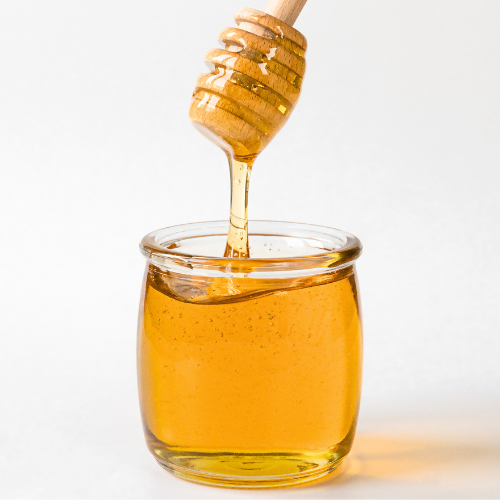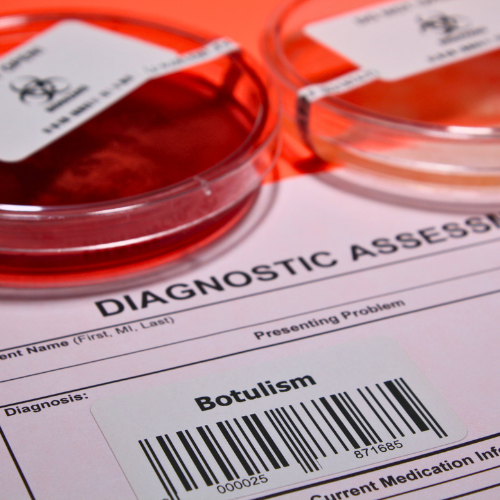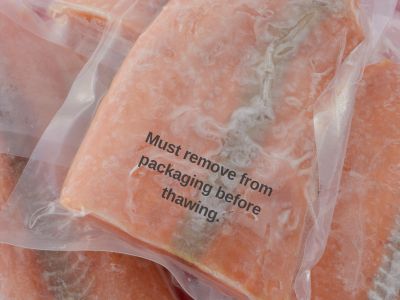By M. Bunning, C. Davis, and P. Kendall*
Quick Facts
- Foodborne botulism is a rare paralytic illness caused by a toxin produced primarily by the spore-forming microorganism, Clostridium botulinum.
- Clostridial spores are widely distributed in the environment; higher numbers of the types associated with foodborne illness have been reported in the soils of the western United States.
- Foodborne botulism results from ingesting food that contains the pre-formed neurotoxin. Home-canned vegetables are the most common cause of outbreaks in the U.S.
- Conditions that favor production of botulism toxin in foods include reduced oxygen, low-acid, low-salt, high-moisture, and storage temperatures above 40°F. Safe methods for preserving and storing food can inhibit the survival of Clostridium organisms.
Botulism is a neuroparalytic disease in humans and animals resulting from the actions of neurotoxins produced by C. botulinum and rare strains of C. butyricum and C. baratii. Species of this bacteria are distributed widely in nature by virtue of their ability to form resistant endospores. Botulism is a serious concern for the food industry, regulatory agencies, and home canners because of the resistance properties of Clostridium botulinum spores and the organism’s ability to grow and form toxin in many foods.
Botulinum neurotoxins (BoNTs) are the most potent protein toxins known to man. In adults, foodborne botulism occurs following ingestion of preformed BoNT in foods that are consumed but the ingestion of spores usually does not lead to illness. However, due to immature digestive systems, infant botulism results from colonization of ingested spores which leads to toxin production and absorption into the circulation.
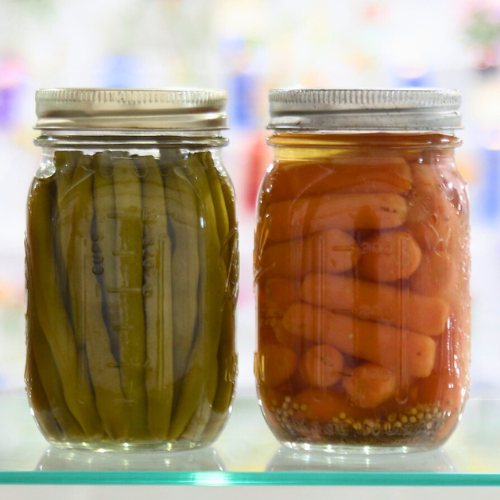
Although these bacteria are commonly found in the environment, the occurrence of botulism is rare because important steps can be taken to ensure food processing environments are unfavorable for its growth and survival. The risk of foodborne botulism has primarily been associated with food improperly canned or unsuitably stored in home kitchens although some incidents have been attributed to commercially produced foods. Consumers preparing food at home must take precautions to ensure homemade foods are preserved and stored safely to avoid the risk of toxin production.
Forms of Botulism
In the United States, about 110 cases of botulism are reported each year. There are several forms, which are grouped by mode of exposure, but symptoms and treatment are generally similar.
- Foodborne botulism: ingestion of foods contaminated with preformed toxin.
- Infant botulism: intestinal colonization of spores resulting in toxin production in children under the age of 1.
- Wound botulism: wound colonization and toxin production.
- Intestinal colonization: occurs in people over the age of one year and harbors the C. botulinum toxin within the gastrointestinal tract (infantile botulism in older children and adults).
- Iatrogenic botulism: when cosmetic or therapeutic procedures that use C. botulinum toxin cause systemic intoxication.
Approximately 25% of botulism illnesses are foodborne. The Centers for Disease Control and Prevention (CDC) reports that five western states – California, Washington, Colorado, Oregon, and Alaska – account for more than half of all reported foodborne botulism outbreaks since 1950. All forms of botulism can be fatal and are considered medical emergencies. Foodborne botulism is a public health emergency because many people can be poisoned by eating a contaminated food. Improperly home-canned foods are the most common cause of botulism outbreaks in the United States.
Causes of toxin exposure from canned food include: failure to follow scientifically tested (USDA researched) home canning instructions, pressure canners not being used when needed, signs of food spoilage being ignored, and lack of awareness that improperly preserving food could result in botulism. Cases of botulism have also been associated with improper storage of perishable foods at room temperature. Tested recipes are available from the National Center for Home Food Preservation and university Extension services (Preserve Smart Colorado).
Infant botulism, first recognized in 1976, now accounts for about 70% of U.S. cases. This illness occurs when infants less than 12 months old ingest viable botulinum spores that germinate, grow, and produce the neurotoxin within their intestinal tract. Spores are found in dust and soil and can contaminate honey or corn syrup. Although these are the only food items known to be associated with infant botulism, the possibility exists for contamination with the spores from any raw or unprocessed food, especially if it is not thoroughly washed. Infants should be protected from excessively dusty or muddy conditions, including vacuum cleaner dust. Children less than one year old should not be given honey or foods containing honey.
Wound botulism can occur if spores are introduced into a wound; intravenous-drug users have a higher chance of developing this illness.
History of Foodborne Botulism
The processes of canning and fermenting foods are particularly conducive to creating the reduced oxygen conditions that allow C. botulinum spores to germinate. Foodborne botulism was first identified in Europe during the 1800s as a problem in fermented sausages, which provided an oxygen free, moist environment favoring the sporulation and growth of bacterial cells. Due to a lack of refrigeration at that time, foods were often stored at room temperature. Because of frequent problems with sausages, the disease was named botulism after the Latin word for sausage, botulus. Issues associated with sausages decreased as refrigeration became available, and nitrates or nitrites were added as curing agents to prevent the germination of botulism spores.
However, when technology developed for sealing shelf-stable foods in cans and jars, botulism became a problem in these types of products. By 1926, most of the problems in the commercial canning industry had been solved. Since then, the majority of foodborne botulism outbreaks in the United States have been caused by improperly home-canned foods, mostly low-acid vegetables, such as string beans, corn, beets, spinach, asparagus, chili peppers, and home-canned meat and fish. Even though C. botulinum toxins occur at low concentrations in contaminated foods, they are extremely potent and very small amounts can have severe consequences.
Although low-acid vegetables and fish have been the chief sources, tomatoes, tomato-based mixtures, and fruits, such as figs, apricots, pears, peaches, applesauce, persimmons and mangoes have also been involved. In some cases, inadequate processing permitted the growth of mold, yeast, or bacteria, which in turn raised the pH of the food sufficiently to permit the growth of C. botulinum. In other cases, reduced acidity may have been due to differences in fruit variety or in the degree of ripeness, pointing to the fact that overripe tomatoes and fruits should not be selected for home canning. With fruits, the syrup added before processing does not become acidic until acid diffuses out of the food’s cells. This process may be hindered if the fruit is not heated (processed) long enough. It should be remembered that this toxin may not give a bad odor or taste to food.
If you suspect spoilage, do not taste food to determine off flavor, but instead:
- put on disposable gloves before handling open containers of food that you think may be contaminated;
- avoid splashing the contaminated food on your skin;
- decontaminate surrounding surfaces using 0.5% sodium hypochlorite solution (1 part household bleach added to 9 parts water) and/or soap and water;
- apply with a disposable paper towel and allow surface to dry thoroughly. Do not use a cleaner that contains ammonia; and
- place the food or can along with the disposable paper towel in a sealed bag and dispose in such a way that it cannot be accessed by humans, pets, or wildlife.
Location & Elevation
Colorado and other states in the West have higher per capita rates of foodborne botulism than other parts of the country. Research has indicated that soils in the western U.S., from the Rocky Mountains to the Pacific Ocean, contain higher numbers of Type A Clostridium botulinum spores, the type of spores that produce the toxin which is most dangerous to humans.
A second factor to consider in the western region is higher elevation. The elevation of Colorado extends from 3315 to 14,433 feet above sea level, with the average being 6800 feet. Since the temperature of boiling water decreases as the elevation increases, the temperature at which foods are processed is lower. To compensate, time or pressure must be adjusted when home canning at higher elevations. For boiling water canning, longer times are needed, which are specified in canning instructions from credible resources. When pressure canning, the pressure for low-acid foods must be increased by 1/2 pound for every 1,000 feet rise in elevation. At 6,000 feet, for example, vegetables must be pressure canned at 13 pounds pressure per square inch rather than the usual 11 pounds recommended in canning instructions designed for elevations between 0 to 2,000 feet. Failure to make these adjustments leads to under-processing and an increased risk of botulism.
Symptoms & Diagnosis
Symptoms of foodborne botulism usually appear within 12 to 36 hours after consumption of contaminated food. In some cases, early symptoms may be gastrointestinal (nausea, vomiting, abdominal pain, constipation, cramps, fullness) and may lead to a false diagnosis of appendicitis, bowel obstruction, or heart attack. The most significant symptoms are blurred double vision, difficulty in swallowing and speaking, and muscle weakness. The diagnosis of foodborne botulism may be delayed because these symptoms can be confused with more common clinical conditions (i.e., stroke, tick paralysis, or shellfish poisoning).
Treatment
The laboratory diagnosis of foodborne botulinum intoxication is based on detection from food samples and/or clinical and stool samples from victims. Unless treatment of foodborne botulism is initiated promptly at the onset of the symptoms, death may result within three to seven days. Improved detection methods and faster access to antitoxins have reduced the death rate from 50% to about 5% in recent years.
Treatment of foodborne botulism involves 1) removing any unabsorbed toxin in the digestive tract, 2) neutralizing the circulating toxin with an antitoxin as quickly as possible, and 3) keeping a patient breathing by a mechanical respirator (ventilator) as necessary. The human botulism antitoxin is administered via intravenous therapy and binds with free botulinum toxin in the body. Antitoxin stops further binding but does not reverse damage. Healing and recovery may take several weeks to months.
Contact information
Most state health departments offer 24-hour assistance in diagnosing botulism and obtaining antitoxin for treatment. In Colorado, contact the State Department of Public Health and Environment at (303) 692-2700 on weekdays or (303) 370-9395 on weekends/evenings if botulism is suspected.
The Botulism Organism
This bacterium exists in two forms: vegetative cells and spores. The spores are the dormant form and can survive high temperatures, up to 240°F, and reduced oxygen environments. Inactive Clostridium botulinum spores are found in soil and water throughout the world. In the spore form, these bacteria are relatively harmless, but risk of toxin production occurs when spores are located in environments that favor germination into vegetative or actively growing cells. As the vegetative cells grow, they become overpopulated and begin to die, resulting in the production of the deadly neurotoxin. Disease transmission is often facilitated via the metabolically dormant spores that are highly resistant to environment stresses, allowing persistence in the environment in unfavorable conditions. Infant and wound botulism infections are initiated upon germination of the spores into neurotoxin producing vegetative cells, whereas foodborne botulism is attributed to ingestion of preformed BoNT.
The vegetative cells and botulism toxin can be destroyed by exposure to normal cooking temperatures, but spore forms are resistant to boiling water temperatures. Spores can also survive for long periods of time when oxygen levels are too high or nutrients are not available, which would inactivate the vegetative cells. A low-oxygen food environment (1) allows spores to produce vegetative cells and (2) allows the growth of vegetative cells, the form which produces the botulism toxin.
There are seven identified types of Clostridial botulism neurotoxins, designated A – G. Human botulism is associated with Types A, B, E, and, very rarely, F. Types A and B are commonly associated with soil, with Type A being more lethal and the type most frequently found in improperly processed home-canned foods. Type E has been associated with ocean and lake water and consequently has frequently been connected to botulism caused by fish and seafood.
Several conditions must be present for the germination and growth of C. botulinum spores. Acid level is a primary factor.
- Acidity. A pH near 7 or neutral favors the growth of C. botulinum, while growth is inhibited at an acidic pH of 4.6 or lower. The pH scale extends from 1 to 14, with foods higher than 4.6 considered low acid foods. The pH of a food also influences the amount of heat needed to kill C. botulinum spores; the higher the pH, the greater the level of heat needed.
- Temperature. Vegetative cells of Types A and B grow between 50 and 122°F, with most rapid growth occurring at 95°F. Type E grows between 38 and 113°F, with an optimum for growth and toxin production at about 86°F. For this type, refrigeration above 38°F may not be a complete safeguard against botulism.
- Oxygen. These organisms cannot grow if air or free oxygen is present in their microenvironment (the area immediately next to them). This area is so small that it is not readily observed. Therefore, it is possible to have conditions develop in a food system whereby air appears to be available, but in reality, there are areas where no oxygen is present and Clostridium botulinum, if present, can germinate and grow. For example, baked potatoes covered tightly with foil and improperly stored at room temperature have been a source of botulism toxin. Anaerobic conditions also develop when food is canned. If the food is not heated to a sufficient temperature for a specified time to kill the spores of Clostridium botulinum during the canning process, the spores can germinate and grow during subsequent storage of the food.
- Moisture. Growth of C. botulinum occurs in high moisture foods. Water activity, or moisture availability, in foods is measured on a 1.0 to zero scale, with pure water being 1.0. For comparison, peanut butter has a water activity around 7.0. The minimum water activity level that permits growth of C. botulinum Types A and B is 0.94 and 0.97 for Type E.
Canning is not the only condition in the manufacture and preservation of foods in which anaerobic conditions can develop.
- Fish is a known source of the bacteria, Clostridium botulinum Type E. This bacteria forms spores that can grow at temperatures above 38°F and without oxygen – such as a vacuum package.
- Thawing instructions need to be followed to prevent formation of toxin, including removing fish from vacuum-sealed packaging prior to thawing.
- Smoked fish can develop anaerobic conditions in the visceral cavity and under the skin. Several botulism outbreaks have been attributed to un-eviscerated fish.
- Anaerobic conditions capable of supporting the growth of C. botulinum also have developed in these foods:
- chopped garlic in oil,
- foil-wrapped baked potatoes,
- unrefrigerated commercially packaged cooked potatoes,
- salsa and roasted chili peppers in plastic bags,
- canned cheese sauce,
- fresh mushrooms in sealed plastic packages without ventilation,
- meat stews and pot pies left at room temperature or in a warming oven overnight.
C. botulinum does not compete well with other microorganisms. In many of the food examples listed, the original cooking or baking step killed competing organisms and eliminated much of the oxygen in the micro-environment under the crust, foil, buttery coating, or packaging. Subsequent storage at warm temperatures created an ideal environment for the germination and growth of botulinum spores. For these types of foods, growth of Clostridium botulinum is inhibited by storage at a low temperature (below 38°F) and/or the use of a preservative, such as sodium nitrite.
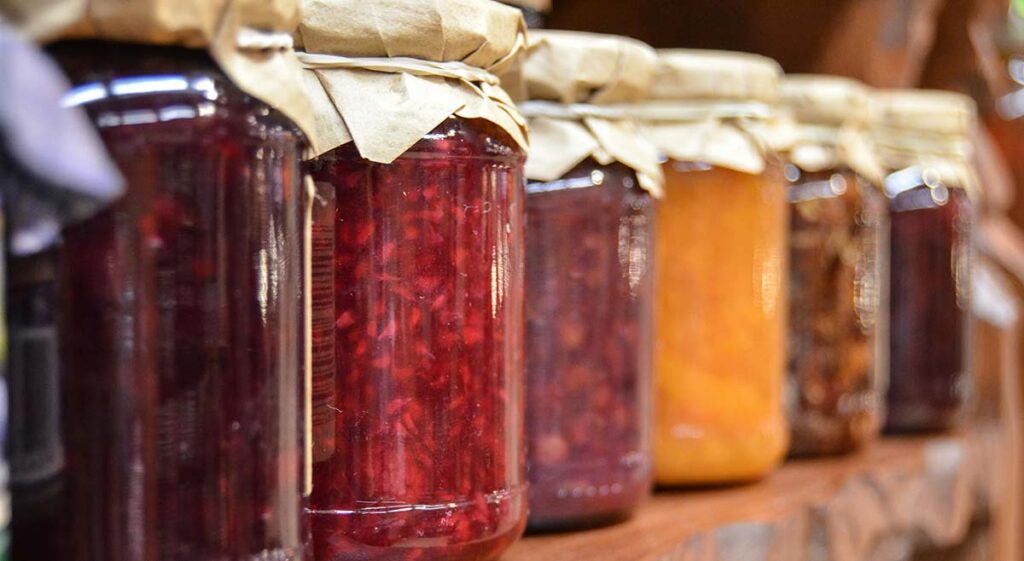
Prevention
The combination of C. botulinum’s resistant spore forms and the toxin-producing anaerobic vegetative cells can create a food preservation challenge and is the reason that specific processing methods are required to prevent sporulation of cells and formation of the toxin. Botulism can be controlled if consumers are aware of the dangers and take steps to prevent spoilage in home-canned and home-cooked foods. Here are some important tips to remember:
- Rinse and clean foods well before cooking or processing. This reduces but does not remove all bacteria. Bacteria are still present on nearly every type of food to be cooked or canned.
- Follow all instructions on sealed packages of frozen fish. Thawing frozen fish in sealed packages creates an environment that can allow toxin to form.
- Be sure all home canning methods are up to date with current research-based recommendations and are properly adjusted for elevation.
- Process all home-canned meats and vegetables (with the exception of tomatoes due to the addition of acid, see information below*), in a steam pressure canner at 240°F for the time recommended in a tested recipe. At sea level to 2,000, a pressure of 11 pounds per square inch (psi) is necessary to reach 240°F. With each 1,000 feet rise in altitude an additional 1/2 psi is needed to achieve 240°F. When using a weighted pressure gauge, the 15 pound weight must be used at all altitudes in Colorado.
- *Acidic foods, such as tomatoes and fruits, if properly selected and processed, do not support the growth of C. botulinum and may be canned in a boiling water bath if current, research-based instructions are followed. The addition of acid in the form of lemon juice, citric acid, or vinegar is recommended as a precautionary measure in all tomato products canned using the boiling water method.
- Before using home-canned food, critically examine the product and container. A bulging lid or leaking jar are signs of spoilage. When you open the jar, look for other signs of spoilage such as spurting liquid, an off odor, or mold.
- As an added precaution at higher elevations, boil all home-canned vegetables and meats without tasting for 10 minutes plus one minute per 1,000 feet above sea level (15 minutes at 5,000 feet) before consuming. Boil home-canned spinach and corn 20 minutes before tasting. Discard food if it looks spoiled, foams, or has an off odor during heating.
If a case of botulism is suspected, seek medical help immediately. Prompt epidemiologic investigation can help prevent additional cases and identify associated foods.
If toxin contamination of a food is suspected, dispose of all spoiled food in a place where it will not be eaten by children, pets, or wildlife. Boil suspect foods for 30 minutes before disposing to ensure that any toxin present will be destroyed.
References & Resources
CDC. 2023. Botulism. Centers for Disease Control and Prevention. National Center for Emerging and Zoonotic Infectious Diseases, Division of Foodborne, Waterborne, and Environmental Diseases. Available at: http://www.cdc.gov/botulism/
Fleck-Derderian S., Shankar M., Rao A.K., Chatham-Stephens K., Adjei S., Sobel J., Meltzer M.I., Meaney-Delman D., and Pillai S.K. 2017. The Epidemiology of Foodborne Botulism Outbreaks: A Systematic Review. Clin Infect Dis. Dec 27;66(suppl_1):S73-S81.
Harvey S.M., Sturgeon J., and Dassey D.E. 2002. Botulism due to Clostridium baratii type F toxin. J Clin Microbiol. Jun;40(6):2260-2. doi: 10.1128/JCM.40.6.2260-2262.2002. PMID: 12037104; PMCID: PMC130751.
Jay, J.J., Loessner, M.J., and Golden, D.A. 2005. Modern Food Microbiology. Seventh edition. Springer, New York, NY.
Johnson, E.A. 2014. CLOSTRIDIUM|Clostridium botulinum In Encyclopedia of Food Microbiology, 2nd edition. Academic Press. C. A. Bat and M. L. Tortorello (eds) pp. 258-462.
Lonati D., Schicchi A., Crevani M., Buscaglia E., Scaravaggi G., Maida F., Cirronis M., Petrolini V.M., and Locatelli C.A. 2020. Foodborne Botulism: Clinical Diagnosis and Medical Treatment. Toxins (Basel). Aug 7;12(8):509. doi: 10.3390/toxins12080509. PMID: 32784744; PMCID: PMC7472133.
Pflug I.J. Science, practice, and human errors in controlling Clostridium botulinum in heat-preserved food in hermetic containers. J Food Prot. 2010 May;73(5):993-1002. doi: 10.4315/0362-028x-73.5.993. PMID: 20501056.
Rawson A.M., Dempster A.W., Humphreys C.M., and Minton N.P. Pathogenicity and virulence of Clostridium botulinum. 2023. Virulence. Dec;14(1):2205251. doi: 10.1080/21505594.2023.2205251. PMID: 37157163; PMCID: PMC10171130.
Sobel, J., Tucker, N., Sulka, A., McLaughlin, J., and Maslanka, S. 2004. Foodborne Botulism in the United States, 1990-2000. Emerging Infectious Diseases, 10:1606-1611.
Van Horn N.L., and Street M. Infantile Botulism. 2023. Jun 12. In: StatPearls [Internet]. Treasure Island (FL): StatPearls Publishing; Jan–. PMID: 29630230.
Wisconsin Food Code Fact Sheet. 2022. Storing and Thawing Vacuum-Packaged Fish. https://datcp.wi.gov/Documents/StoringThawingVacuumPkgdFish.pdf
**M. Bunning, Professor and Extension Specialist, C. Davis, MPH, PhD, and P. Kendall, Professor Emeritus, Colorado State University Department of Food Science and Human Nutrition
Go to top of this page.


